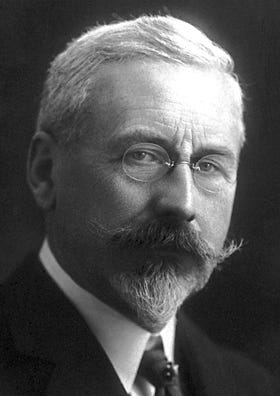Anthony Peratt Claims that Charles-Édouard Guillaume Also Theorized that the Universe is Electric
In the post, Kristian Birkeland Theorized that the Universe is Electric, I quoted Kristian Birkeland (1867-1917), writing about his 1902-1903 voyage to northern Norway to study the aurora borealis, in which he argued that stars are the centers of electric forces of incredible intensity:
According to our manner of looking at the matter, every star in the universe would be the seat and field of activity of electric forces of a strength that no one could imagine.1
In a more recent post, A Temperature for Space was Predicted Long Before the Cosmic Microwave Background Radiation was Discovered and Decades Before the Big Bang was Proposed, I presented the work undertaken by André Assis to recover the various proposals of some kind of temperature or cosmic background radiation, long before the discovery in 1964 of such by Arno Penzias (1933-2024) and Robert Woodrow Wilson (1936-). The earliest such proposal was made by Charles-Édouard Guillaume (1861-1938), winner of the 1920 Nobel Prize in Physics, in an 1896 paper entitled «La température de l’espace»2 (“The temperature of space”). The English-language translation of this paper was published in 2020 by Assis and M.C.D. Neves3.
Wanting to find out more about Guillaume, I had a look at his Wikipedia entry, https://en.wikipedia.org/wiki/Charles_%C3%89douard_Guillaume. Therein, I found the following sentence:
Guillaume was head of the International Bureau of Weights and Measures. He also worked with Kristian Birkeland, serving at the Observatoire de Paris—Section de Meudon. He conducted several experiments with thermostatic measurements at the observatory. [my emphasis]
So I tried to find out, with little success, about this collaboration between Birkeland and Guillaume. I finally came across this note in a paper by Anthony Peratt (1940-):
The observation of a three degree Kelvin background temperature has, since 1965, been used to argue that the universe is finite-dimensioned. However, as early as 1896 Charles Edouard Guillaume in Meudon, France, estimated the temperature of space to be 5-6 K blackbody (Peratt, 1995). No dimension restrictions were placed on the prediction. Guillaume, together with his colleague Birkeland, advocated the dominance of electric forces in space, this pioneering what is now called ‘Electric Space’. Birkeland died as a working committee was nominating him for the Nobel prize in physics in 1917; Guillaume was awarded the Nobel prize in physics in 1920.4
So, if Peratt is correct, Guillaume would also have been, alongside Birkeland, one of the earliest proponents of cosmic electric forces. Unfortunately, for the moment, I have not been able to find further information thereon.
I therefore endeavoured to contact Alv Egeland (1932-2025), the first author of the excellent biography Kristian Birkeland: The First Space Scientist5. Unfortunately, Egeland passed away on May 3rd, 2025, less than two months ago. Requiescat in pace.
I will continue to research this topic, and hope that some of my readers might be able to find some relevant books or links.
If you wish to donate to support my work, please use the Buy Me a Coffee app.
Kr. Birkeland. The Norwegian Aurora Polaris Expeditions 1902-1903. Volume 1: On the Cause of Magnetic Storms and the Origin of Terrestrial Magnetism. Christiana: H. Aschehoug & Co., First Section: 1908. Second Section: 1913. The quote is from Second section, p.720.
The two sections are available as a single PDF file from the CERN Document Server: https://cds.cern.ch/record/1395529/files/norwegianaurorap01chririch.pdf
Ch.Ed. Guillaume. La température de l’espace. La Nature 1214:210–211,234 (1896).
A. K. T. Assis and M. C. D. Neves, “Complete and commented translation of Guillaume's 1896 paper on the temperature of space”, American Journal of Physics 88:1140-1144, 2020. Available at:
https://www.ifi.unicamp.br/~assis/Am-J-Phys-V88-p1140-1144(2020).pdf
Anthony L. Peratt. Advances in Numerical Modeling of Astrophysical and Space Plasmas. Part II. Astrophysical Force Laws on the Large Scale. Astrophysics and Space Science 256:51-75, 1998. Quote is from note, p.52.
Alv Egeland and William J. Burke. Kristian Birkeland: The First Space Scientist. Springer, 2005.




"So, if Peratt is correct, Guillaume would also have been, alongside Birkeland, one of the earliest proponents of cosmic electric forces."
George Woodward Warder wrote The Universe a Vast Electric Organism which was published in 1904. I bought it, got through a chapter or two but it's a bit too poetic for me, though he seems to know what he was talking about. He has a chapter called, Recent Electrical Discoveries and mentions Maxwell's electro-magnetic theory of light in the first few paragraphs. Just looked him up, he's classified as a "poet philosopher", so that explains it.
If one looks at eastern metaphysics obliquely, one sees the concept of an electric universe never died, only our consciousness of it did. It's returning now. The concept of "Agni" and even "Atman" is pretty close to the idea of the atom or at least a fiery electro-magnetic principle, but its nuances extend indefinitely.
Keep up this research, John, I'm convinced people only accept CMB is "proof" of the Big Bang because they're kept ignorant of these details. I like the way Peratt makes us aware that the Big Bang is not an "amazing" discover, but a closing down of the idea of infinity, which - as Pascal and Blake knew - is a closing down of progressive political ideas too.